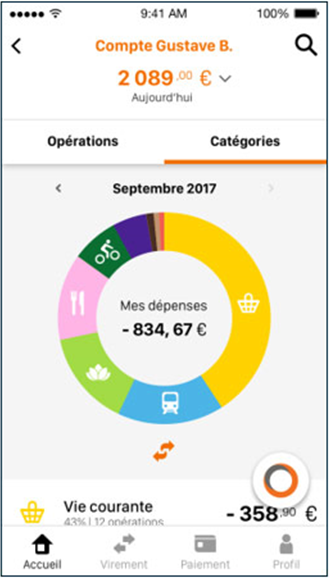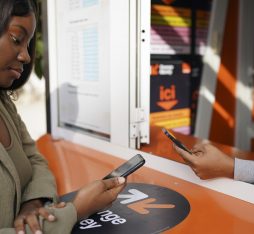“Does the use of a banking application for account management lead to the adoption of good budgetary practices? The answer is mixed”
Of all the digital tools available today for tracking activities, banking apps for monitoring spending stand out for their success. In France, 55% of people have downloaded at least one such app, and 89% of them check it at least once a week [1]. Initially offered via personal spaces on banking websites, account tracking tools are now some of the most frequently consulted smartphone apps.
The success of banking applications is a new chapter in the history of home accounting, which underwent two major changes in the 1960s and 70s. The advent of monthly salaries and the concomitant opening of bank accounts by the French population made a lasting mark on household accounting practices [2]. After the success of chip cards (in the late 1980s), the rise of FinTechs in the 2010 complexified the banking services landscape and involved a growing number of stakeholders: traditional players who have gone digital; online banks; new payment solutions, including mobile payment; account aggregators; and producers of Personal Finance Management (PFM) solutions or multi-person expenditure management solutions. The innovations in the sector are prompting users to adopt new practices to manage their account(s). These dramatic changes, which raise questions about how individuals’ trust is built [3], also raise questions about a potential improvement of their budget management skills. According to its promoters, self-tracking, i.e. the self-monitoring of one’s own traces of activity, participates in the development of a better knowledge of oneself. What about banking traces? Do interfaces for performing and tracking transactions from a smartphone promote better management of accounts, as they promise?

The survey proposes two angles: firstly, an analysis of the need for budget management aids in France; and secondly, a sociological description of the transformations happening in practices. This article first introduces the exploration of new banking services through an analysis of the need for financial literacy education among the French population and the need to start thinking about possible new forms such education could take in the digital age [4]. The article then reports on an original sociological study, conducted in 2016, based on analysis of the features of around fifty systems and in-depth interviews with 12 users [5]. It offers a mixed initial verdict on the role of new technologies in the spread of “good” accounting practices: while a culture of self-reflection and self-observation is spreading through the use of these tools [6], they promote real-time budget management that deviates from the institutional recommendations on the subject.
An education in budgeting
The prospect of simplifying tasks is often at the heart of the rhetoric accompanying digital product and service offers, and tools dedicated to household budget management are no exception. Simplification is not the only promise, however. Such tools also widely purport to encourage better financial management through the use of digital tools. This angle is supported by public policies designed to raise the population’s skills in this area.
Financial literacy has become an important social goal. The term covers budgeting skills and learning how to use banking tools (as well as an elementary understanding of economic concepts and public policies). The general public’s skills in this area were deemed too limited by organisations such as the OECD from the 1990s onward. And international comparisons suggest that the French are well behind their European neighbours. A strategy for educating the French public on economic, budgeting and financial matters was set up in 2016, at the request of the Ministry of Finance. Run by the Banque de France, it is based on five pillars. One of them involves supporting budgeting and financial skills throughout people’s lives, by providing everyone with carefully chosen, neutral, educational, up-to-date, free information, as well as easy-to-grasp decision-making aids. While taking care of vulnerable populations – young people and people in financial difficulty – is described as taking place primarily through human support, as part of schooling or social intervention, use of self-training solutions based on digital tools is also promoted. Information websites and digital decision-making aids must play their role in guiding individuals towards good practices. For instance, in November 2019, the strategic committee for financial literacy (which comprises over 20 members from institutions and the non-profit sector) announced the design of a mobile app for 17- to 25-year-olds covering financial literacy concepts.
FinTechs have identified the fact that promoting financial literacy among young people offered new market opportunities, and are providing real support to teenagers, on subjects from managing their pocket money to financial independence. In 2019, three online banks targeting young people were launched: Xaalys, Pixpay and Kard. These “educational” offers are all focused on a playful mobile app, a personalised Mastercard requiring systematic authorisation of all transactions, and incremental parental control and savings functions. Young people are being clearly targeted by educational efforts, but the entire public is also being encouraged to “better manage” their money from day to day via budget tracking offers.
“Best practices” not embedded in all tools to the same extent
The sociological survey covers fifty account management assistance apps distributed in France (from bank apps such as Société Générale, Boursorama and Hello bank to account aggregators like Bankin and Linxo). Their features were systematically identified and compared with the operations advocated by social workers and the websites of the institutions responsible for promoting financial literacy [7]. Analysis of the scripts embedded in the tools reveals discrepancies with the rules advocated.
Indeed, a review of literature sources [5] shows a consensus around the six most commonly recommended rules of behaviour, presented here in order of the importance given to them by their promoters. 1) Doing your accounts regularly (at least once a month) involves checking your balance and checking each expenditure item on your statements to make sure there are no errors. 2) Sorting your expenses by degree of necessity involves prioritising them into three levels to identify possible savings: fixed expenses (prior commitments) over which the individual has little short-term control; everyday expenses (food, transport, etc.), which it is possible to reduce but not drastically; and occasional expenses (clothing, holidays, etc.), which can be limited. 3) Saving means putting money aside regularly in a designated account, by automatic transfer if possible. 4) Breaking down your expenses into monthly payments means breaking up major expenditure items such as taxes. 5) Establishing a provisional annual budget involves identifying the resources and outgoings you expect to have (often based on the previous year) and breaking them down month by month. 6) Finally, categorising your expenses (housing, food, etc.) enables you to identify their respective importance in your budget and make adjustments if necessary.
If all of these operations are indeed covered by account management software, they require long and painstaking work from the user to transfer the data and manually categorise expenditure items, which most smartphone apps propose to reduce and simplify. By automating the categorisation of certain expenditure items, based directly on the associated bank accounts, they propose to reduce time spent on manual operations and display the data in concise and easy-to-use visualisations: account balance, change in balance over time, etc.
Systematic identification of the features present in the apps and the preferred forms of data visualisation shows that they favour real-time budget management. They facilitate account management by offering alerts and notifications that allow users to check their balances and transactions on a daily basis. They also emphasise the possibility of keeping the data and tracking the changes in one’s accounts over time, as well as having a better idea of how expenditure is spread out across various categories, an operation given little prominence in the literature on financial literacy. Conversely, operations to prioritise expenses by degree of necessity and spread expenses out equally over time are much less present in the interfaces of apps than in the discourse about promoting financial literacy.
Balance checking is the core use
The survey was supplemented by in-depth interviews with 12 users of digital home accounting assistance tools. They show that users adopt these technical systems in various different ways. Even though adoption and configuration of the features vary considerably from one user to another, some common traits emerge from respondents’ practices. First, using a banking app to manage one’s accounts is a decision that is taken quickly and which lasts, without having to invest much time getting to grips with the tool. Unlike the often intermittent use of self-tracking to monitor sleep or steps, monitoring one’s budget on a mobile has become a regular and intensive practice for all respondents, who have no intention of giving up. Two others results concerning account management and sorting of expenses are particularly noteworthy.
Banking apps are primarily used for one basic account management operation: checking one’s balance. This is a vital feature, while only some respondents use the expense categorisation capabilities to check their spending or obtain an alert in the event of a low balance. Checking one’s balance on one’s smartphone is considered much more practical than printing it out at a cash dispenser or looking at paper statements. “I actually look at it every day, and at the start of the month, I sometimes look two or three times a day – once in the morning, once at lunchtime and once in the evening – to see if anything has happened, if I have been paid, things like that.” (Lison, 24, student). A single mother keeps track of her efforts to stay within her budget every day: “I’m really happy because as soon as I open it, it’s the first thing I see. I find that reassuring.” (Djamila, 38, airport security officer). Checking one’s balance has now become a micro-task that people do every day almost without thinking, based on an automated calculation. It allows users to make adjustments in real time “in reaction” to what they see, says another interviewee, to allow oneself certain expenses or put off others, and to make transfers between one’s current and savings accounts. Account management is now established as a little part of everyday life – it is about checking and adjusting, rather than sitting down for retrospective accounting sessions.
Despite the technical promises about automated sorting of expenses by category, applications are struggling to convince users of the merits of their analytical functions. Accumulation, sequencing and categorisation of banking data seem to be underused. “I was expecting to get some kind of understanding out of it (…). I already know that my rent costs me a fortune. I already know that my child costs me a fortune, that the rest goes on food, and that from time to time we spend money on holidays. I know all of that. What do I do with all that information?” (Samuel, 36, project manager). Only some of the young people surveyed say they have learned about themselves by looking at the information about their different categories of spending. More broadly, the concept of goal setting, so important in most self-tracking tools to guide users in their reading of the data recorded, is almost totally absent in the use of banking apps, the sole goal being to keep one’s balance in the black. The survey respondents do not use banking apps to learn how to manage their budget better: they do not set a budget in advance, predetermine the amounts they wish to save, or seek to spread out their expenses over the year, still less prioritise them by degree of necessity.
Despite the promises of guiding the public towards better management of their finances, the survey of users suggests that using banking apps has promoted the adoption of a method of managing one’s accounts that is quite a long way from the rules advocated in financial literacy. Far from helping to make individuals anticipate and plan their budgets, bank management tools enable real-time self-monitoring while leaving room for considerable personalisation of usage practices. In order to integrate an inclusive and responsible positioning at the heart of innovative solutions, these results invite to finely articulate the design of banking applications with a knowledge of the actual uses of the general public. On the strength of this conviction, and in consultation with the Orange Mobile Finance teams, a research-action project to design an educational banking device is currently underway, as part of a thesis in educational science [8]. The reflection on this ambitious objective will have to take into account the current transformations (massification of online consumption, digitalization of new means of payment and decrease of cash) and their impacts on ordinary accounting practices. It is still a long way to go before the return of banking data to individuals becomes a lever for financial skills, but the impressive success of banking applications in all segments of the population is an encouraging context.
[1] Etude Fédération Banque Française-IFOP. Les Français, leur banque, leurs attentes, 2018.
[2] O. Feiertag, La bancarisation de la société française dans les années 1968, in Y. Marec et al. Les français et l’argent XIXe-XXIe, 2011.
[3] P. de Leusse, After Banking. Banques et confiance : la grande réconciliation digitale. Débats Publics éditions, 2019.
[4] B. Foucault, E. Le Huérou et F. Toutain, L’éducation financière, un levier de confiance pour les banques, Research Memo Orange, 2019.
[5] O. Nouhant et A.-S. Pharabod, Suivre ses dépenses sur mobile, Rapport de stage Orange, 2016
[6] D. Lupton, Self-tracking cultures: towards a sociology of personal informatics, OzCHI, 2014.
[7] J. Lazarus, L’ascension de la financial literacy, in S. Dubuisson-Quellier, Gouverner les conduites, 2016.
[8] A. Scherer, Conception d’un dispositif numérique d’éducation financière, à partir de l’analyse de l’activité des acteurs. Thèse en sciences de l’éducation, en cours.










